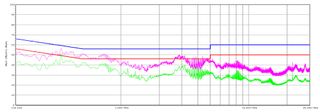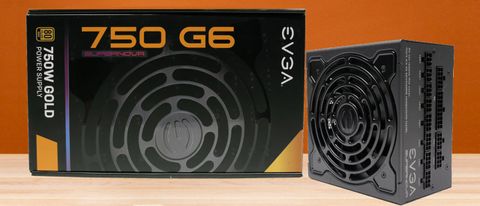Why you can trust Tom's Hardware
Advanced Transient Response Tests
For details about our transient response testing, please click here.
In the real world, power supplies are always working with loads that change. It's of immense importance, then, for the PSU to keep its rails within the ATX specification's defined ranges. The smaller the deviations, the more stable your PC will be with less stress applied to its components.
We should note that the ATX spec requires capacitive loading during the transient rests, but in our methodology, we also choose to apply a worst case scenario with no additional capacitance on the rails.
Advanced Transient Response at 20% – 20ms
| Voltage | Before | After | Change | Pass/Fail |
| 12V | 12.151V | 12.013V | 1.13% | Pass |
| 5V | 5.022V | 4.940V | 1.63% | Pass |
| 3.3V | 3.330V | 3.186V | 4.33% | Pass |
| 5VSB | 5.068V | 5.018V | 0.98% | Pass |
Advanced Transient Response at 20% – 10ms
| Voltage | Before | After | Change | Pass/Fail |
| 12V | 12.154V | 12.027V | 1.04% | Pass |
| 5V | 5.022V | 4.936V | 1.71% | Pass |
| 3.3V | 3.331V | 3.188V | 4.30% | Pass |
| 5VSB | 5.068V | 5.012V | 1.10% | Pass |
Advanced Transient Response at 20% – 1ms
| Voltage | Before | After | Change | Pass/Fail |
| 12V | 12.155V | 12.048V | 0.88% | Pass |
| 5V | 5.022V | 4.938V | 1.68% | Pass |
| 3.3V | 3.331V | 3.163V | 5.06% | Pass |
| 5VSB | 5.068V | 5.009V | 1.15% | Pass |
Advanced Transient Response at 50% – 20ms
| Voltage | Before | After | Change | Pass/Fail |
| 12V | 12.146V | 12.023V | 1.01% | Pass |
| 5V | 5.015V | 4.929V | 1.71% | Pass |
| 3.3V | 3.324V | 3.173V | 4.53% | Pass |
| 5VSB | 5.034V | 4.986V | 0.95% | Pass |
Advanced Transient Response at 50% – 10ms
| Voltage | Before | After | Change | Pass/Fail |
| 12V | 12.148V | 12.031V | 0.96% | Pass |
| 5V | 5.015V | 4.926V | 1.78% | Pass |
| 3.3V | 3.324V | 3.174V | 4.51% | Pass |
| 5VSB | 5.034V | 4.975V | 1.17% | Pass |
Advanced Transient Response at 50% – 1ms
| Voltage | Before | After | Change | Pass/Fail |
| 12V | 12.141V | 12.036V | 0.87% | Pass |
| 5V | 5.014V | 4.927V | 1.74% | Pass |
| 3.3V | 3.323V | 3.175V | 4.44% | Pass |
| 5VSB | 5.034V | 4.965V | 1.37% | Pass |








Transient response is good at 12V, 5V and 5VSB, but needs work at 3.3V.
Turn-On Transient Tests
In the next set of tests, we measure the PSU's response in simpler transient load scenarios —during its power-on phase. Ideally, we don't want to see any voltage overshoots or spikes since those put a lot of stress on the DC-DC converters of installed components.

Turn-On Transient Response Scope Shots


Turn-on transient response is almost perfect.
Power Supply Timing Tests
There are several signals generated by the power supply, which need to be within specified, by the ATX spec, ranges. If they are not, there can be compatibility issues with other system parts, especially mainboards. From year 2020, the PSU's Power-on time (T1) has to be lower than 150ms and the PWR_OK delay (T3) from 100 to 150ms, to be compatible with the Alternative Sleep Mode.
| T1 (Power-on time) & T3 (PWR_OK delay) | ||
|---|---|---|
| Load | T1 | T3 |
| 20% | 88ms | 132ms |
| 100% | 88ms | 132ms |
The PWR_OK delay is within the 100-150ms region, so the PSU supports the alternative sleep mode recommended by the ATX spec.
Ripple Measurements
Ripple represents the AC fluctuations (periodic) and noise (random) found in the PSU's DC rails. This phenomenon significantly decreases the capacitors' lifespan because it causes them to run hotter. A 10-degree Celsius increase can cut into a cap's useful life by 50%. Ripple also plays an important role in overall system stability, especially when overclocking is involved.
The ripple limits, according to the ATX specification, are 120mV (+12V) and 50mV (5V, 3.3V, and 5VSB).
| Test | 12V | 5V | 3.3V | 5VSB | Pass/Fail |
| 10% Load | 11.1 mV | 3.9 mV | 6.1 mV | 6.2 mV | Pass |
| 20% Load | 9.4 mV | 4.1 mV | 6.6 mV | 6.7 mV | Pass |
| 30% Load | 9.1 mV | 8.2 mV | 9.4 mV | 7.5 mV | Pass |
| 40% Load | 6.0 mV | 5.3 mV | 8.3 mV | 10.3 mV | Pass |
| 50% Load | 6.1 mV | 6.0 mV | 8.5 mV | 9.5 mV | Pass |
| 60% Load | 5.7 mV | 6.3 mV | 8.7 mV | 9.3 mV | Pass |
| 70% Load | 6.7 mV | 7.0 mV | 9.5 mV | 13.3 mV | Pass |
| 80% Load | 7.2 mV | 7.5 mV | 11.4 mV | 14.8 mV | Pass |
| 90% Load | 7.7 mV | 7.9 mV | 11.8 mV | 12.9 mV | Pass |
| 100% Load | 11.1 mV | 8.1 mV | 13.0 mV | 15.4 mV | Pass |
| 110% Load | 11.3 mV | 9.2 mV | 15.0 mV | 16.4 mV | Pass |
| Crossload 1 | 12.9 mV | 6.3 mV | 12.3 mV | 8.4 mV | Pass |
| Crossload 2 | 13.6 mV | 6.2 mV | 7.3 mV | 7.8 mV | Pass |
| Crossload 3 | 15.3 mV | 5.0 mV | 13.7 mV | 7.6 mV | Pass |
| Crossload 4 | 11.0 mV | 6.9 mV | 10.6 mV | 14.7 mV | Pass |




Ripple suppression is excellent on all rails, without using extra in-cable caps.
Ripple At Full Load




Ripple At 110% Load




Ripple At Cross-Load 1




Ripple At Cross-Load 4




EMC Pre-Compliance Testing – Average & Quasi-Peak EMI Detector Results
Electromagnetic Compatibility (EMC) is the ability of a device to operate properly in its environment without disrupting the proper operation of other nearby devices.
Electromagnetic Interference (EMI) stands for the electromagnetic energy a device emits, and it can cause problems in other nearby devices if too high. For example, it can be the cause of increased static noise in your headphones or/and speakers.

EMI emissions are low in general. With the average EMI detector, there is only a spur exceeding the limit at 338 kHz, but everything is fine with the peak EMI detector.
MORE: Best Power Supplies
MORE: How We Test Power Supplies
MORE: All Power Supply Content
Current page: Transient Response Tests, Timing Tests, Ripple Measurements and EMC Pre-Compliance Testing
Prev Page Protection Features, DC Power Sequencing, Cross-Load Tests and Infrared Images Next Page Performance, Noise, Efficiency and Power FactorAris Mpitziopoulos is a Contributing Editor at Tom's Hardware US, covering PSUs.
-
Johnpombrio It is amazing how many different power supplies EVGA makes. There is the usual 550,650,750,850, 1000, and 1600 watts. The GA, GM, GT, GQ, a plain, cheap G+, and so many others. Then comes the superNOVA branded ones with their G(gold), P(platinum), and T (titanium) efficiencies. Each of THESE superNOVA families has G2, G3, G5, and G6: P2 through P6; and the super expensive T series. I have an EVGA superNOVA 850 G2 which I bought because it was on a great sale and I trust EVGA in most things. I hope a good rating on a 750 G6 means a good rating on a superNOVA 850 G6 which will be needed with my Alder Lake build coming up.Reply
